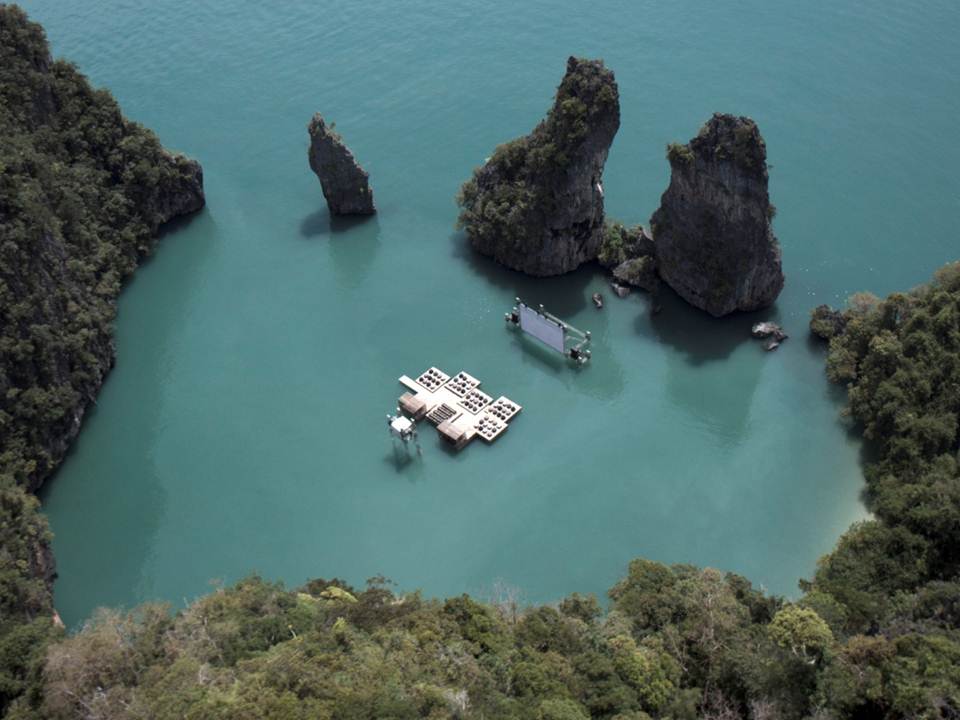A Floating Movie Theater

Archipelago Cinema
{% blockquote -Ole Scheeren http://www.buro-os.com/archipelago_cinema/ Archipelago Cinema %} A landscape of pieces playfully joined together. A sense of temporality, randomness. Almost like drift wood. Or maybe something more architectural. Modular pieces, loosely assembled, like a group of little islands. A congregation of rafts as an auditorium. Archipelago Cinema. {% endblockquote %}
Now this is cool. From March 9th to 13th, while I was getting my cinematic fill at SXSW, Tilda Swinton and Apichatpong Weerasethakul served as curators for a new and unique film festival, Film on the Rocks Yao Noi. Started by Nat Sarasas and Chomwan Weeraworawit, the fest appears to be a highly free-form exploration of art, cinema and space, as well as a boon to the Thai film industry which now enjoys some time in the spotlight after Weerasethakul’s 2010 Palme D’Or win for Uncle Boonmee Who Can Recall His Past Lives.
The event took place on an archipelago off Thailand. Italian Vogue’s Carlotta Loverini Botta was on-hand for the festivities. Here’s what was she wrote about the fest’s second day1:
…we were actually taking part in the village’s celebration day, in which the screen was mounted in the middle of a market/fun-fair open to the population of all villages and screening one of the historic pieces of the Festival’s partner, the Thai Film Foundation and Film Archive, the first Thai silent horror movie dubbed live by actors so talented that it was impossible to choose between watching the screening or the actors’ performance.
The real centerpiece of the fest, however was the “Floating Auditorium” pictured above. The impermanent theater, erected between two rocks, was designed by architect Ole Scheeren based on a design “borrowed” from local Thai fishermen. From the project’s Web site:
Local fishermen farm lobsters on rafts. Wooden frames are tied by rubber straps to foam blocks wrapped in mosquito nets. A simple construction. A local technique. Adopted to build the floating cinema.
Scheeren has toyed with outdoor cinema spaces before. In 2006 he designed the “Marfa Drive-In,” a new take on an old idea in the West Texas desert. It’s always nice to see public art and cinema collide like this. I am particularly intrigued by the way Scheeren is approaching public viewing in these projects.
Honestly, watching a movie at sea, where the screen and the projector are on different platforms, sounds disorienting. I’m sure the lagoon waters are calm, but what of the people fidgeting on the platform?
Caroline Lever at Dazed Digital seemed to have no complaints:
Surrounded by rocks forming a natural theatre, we reclined on modular rafts held together like a cluster of islands. And with the undulating waves under us, and the stars above, we returned to a state of naivete and wonder to Herbert Brenon’s Peter Pan, accompanied by a magnificent live score performed by Simon Fischer Turner.
Brenon’s 1924 silent picture is the first filmed version of J. M. Barrie’s play.2 I’ve never seen it, but a quick search on YouTube gives a brief idea of one of the tale’s pivotal moments.
I imagine the screen border, wobbling near the picture’s edges, would make some viewers (like me) a bit uneasy. But perhaps that is the point. Why do an eminently “indoor” activity like watching a movie against such a beautiful backdrop? Could cinema ever recreate the beauty of sitting among friends on a raft in the evening? Does the space trump the film completely, and if so is that a problem?
The Film on the Rocks tumblr has some great photos and stories from the four day event.
-
This translation is provided by Vogue’s English site, but I gather it’s a bit clunky. I’m copying the text verbatim save for one emphasis removal. ↩︎
-
Barrie was even involved with the production, selecting actress Betty Bronson for the eponymous lost boy. ↩︎